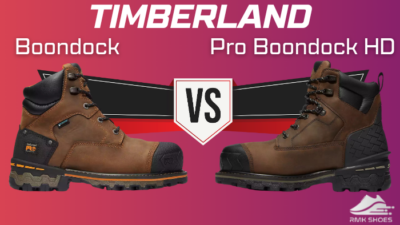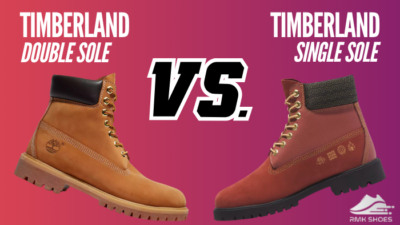Dive into the battle of the boots as I compare Timberland’s Heritage and Premium lines.
Does the classic Heritage still reign supreme, or does the upgraded Premium version offer more bang for your buck?
I’ll break down the key differences in materials, comfort, durability, and price to help you choose the perfect pair for your needs, wants, and wallet.
So, lace up and get ready to discover your Timberland champion!
An Overview of the Timberland Premium and Heritage
Timberland’s Premium and Heritage lines represent two distinct yet interconnected facets of the brand’s identity.
Premium focuses on modern interpretations of classic Timberland styles. It prioritizes comfort and elevated materials.
The soft nubuck leather boots have updated silhouettes, premium waterproof construction, and subtle design tweaks that complement the brand’s legacy.
This line is ideal for those who appreciate timeless Timberland designs with a modern touch.
Conversely, Heritage dives deep into Timberland’s roots.
It features faithful reproductions of iconic styles like the original yellow Timberland work boots, the Timberland 6-inch, and the boat shoe, made with traditional materials and construction methods.
This line is for purists who crave the authenticity and ruggedness that made Timberland famous. 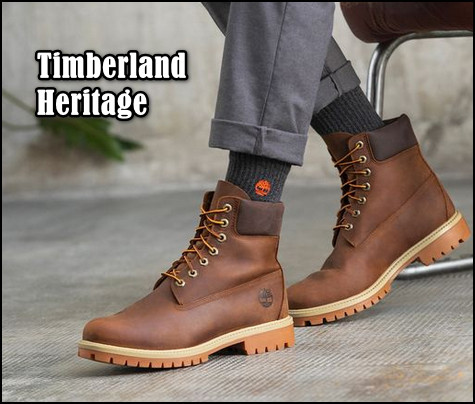
While both lines offer high-quality footwear, their target audiences differ. Premium appeals to those seeking a contemporary take on classic styles, while Heritage attracts those who value authenticity and historical significance.
Characteristic Comparison between Timberland Heritage and Premium Boots
Both Timberland lineups produce excellent boots. Familiarizing yourself with their features allows you to make well-informed choices that align with your style and comfort preferences.
| Features | Timberland Heritage | Timberland Premium |
|---|---|---|
| Insulation | 200g PrimaLoft® Insulation | 400g PrimaLoft® Eco Insulation |
| Upper | Waterproof Premium Timberland® leather | Waterproof nubuck Premium Timberland® leather |
| Lining | ReBOTL™ fabric lining | Faux Shearling Lining |
| Insole | Anti-fatigue removable footbed | Anti-fatigue removable footbed, EVA foam cushioning |
| Outsole | Rubber lugs | Rubber lugs |
| Waterproofing | Seam-sealed and waterproof | Seam-sealed and waterproof |
| Durability | Excellent | Good |
| Comfort | Less comfortable, especially during long wear | More comfortable due to the padded collar and thicker sole |
| Design | Classic workwear aesthetic | Sleeker, more refined design |
| Color Options | Wide range, including iconic olive and black nubuck | Versatile neutrals like black, dark brown, yellow |
| Versatility | Casual and outdoor settings | Simple and smart casual occasions |
| Price Range | $198 to $220 | $170 to $200 |
| Perceived Value | Higher due to premium materials and craftsmanship | Affordable without compromising quality |
| Best for | Everyday wear, light weather | Everyday wear, colder weather, comfort-focused wearers |
Now, go through the following section. It explains everything you need to know before buying the Timberland Heritage or Premium.
6 Key Differences between Timberland Heritage and Timberland Premium
Understanding the distinctions between Heritage and Premium Timbs is vital for individuals seeking the ideal footwear. Key factors such as technology, materials, support, durability, and prices are crucial in shaping your overall experience.
Here, I’ve outlined the primary differences between Heritage and Premium.
1. Features & Technologies
As I explored the Timberland Heritage and Premium models, the distinct features of each left a lasting impression on me.
PrimaLoft® Insulation
Firstly, the PrimaLoft® Insulation in both collections caught my attention.
The Heritage line boasts a soft, lightweight, and compressible down alternative with a patented microfiber structure, ensuring warmth retention even when wet.
On the other hand, the Premium collection features PrimaLoft® Eco Insulation, derived from 50% recycled PET. It delivers a similar promise of maintaining warmth in damp conditions.
The eco-friendly insulation in both collections aligns with my values.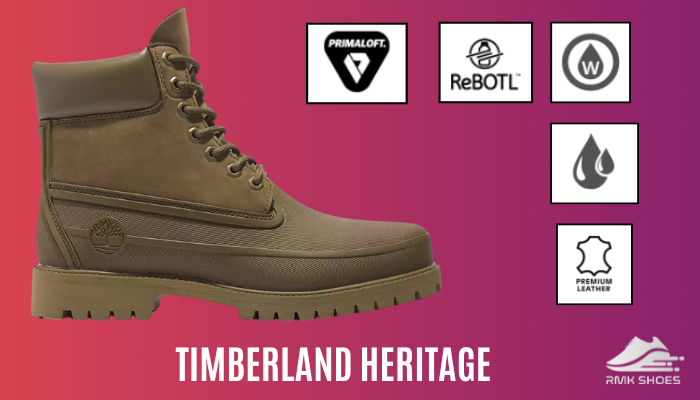
Sustainable Materials
The Heritage’s ReBOTL™ Material stands out with over 50% recycled PET, excluding trace materials. It highlights Timberland’s commitment to sustainability.
Similarly, the Premium line incorporates ReBOTL Fabric, which is also made from recycled PET bottles. This approach effectively reduces the environmental impact by 50%.
Waterproofing Technology
In terms of waterproofing, both the Heritage and Premium collections shine.
The Heritage boots come with Waterproof Seam-Sealed technology, featuring durable waterproof leather with special tanning for moisture-repelling lasting protection.
In contrast, the Premium collection emphasizes a more straightforward Waterproof design with seam-sealed and treated fabrics. It provides reliable protection in wet conditions.
Leather Manufacturing
Regarding the type of leather used, the Heritage models boast Premium Timberland® Leather, supporting responsible leather manufacturing.
On the contrary, the Premium line emphasizes a Certified Tannery approach, ensuring that 50% of the leather comes from Silver-rated or higher facilities, assessed by the Leather Working Group.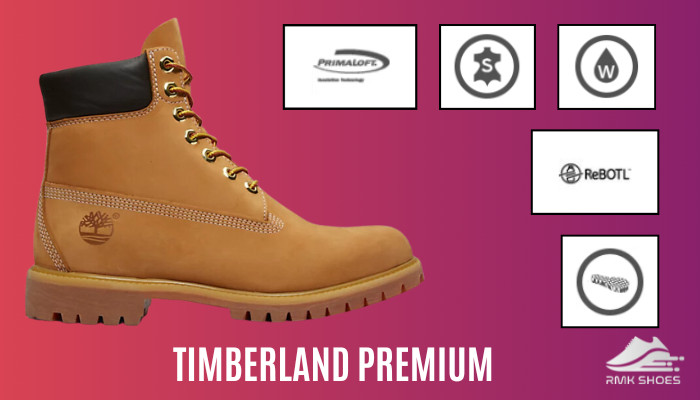
Comfort Innovation
The Timberland Premium boots introduce an intriguing feature: Anti-Fatigue Technology.
The midsole with geometric cone support promises long-lasting comfort and shock absorption, enhancing the boots’ overall experience.
This unique feature sets the Premium collection apart in terms of comfort, providing a potential edge over the Heritage line.
2. Materials and Construction
Timberland Premium vs. Heritage: A battle of classic charm and modern luxury.
Upper
The Timberland Heritage boasts waterproof premium Timberland® leather in its upper. It is super durable and can handle whatever weather comes its way.
On the other hand, the Timberland Premium steps it up with waterproof nubuck Premium Timberland® Leather. It offers a slightly different texture but still maintains that essential waterproof feature.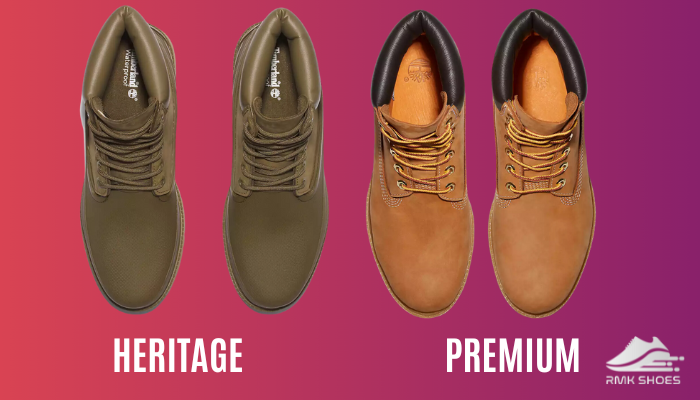
The Premium’s nubuck leather gave me a more luxurious feel, but both are top-notch in quality.
Insulation
Premium and Heritage boots have got you covered when keeping your feet warm.
The Heritage packs 200g of PrimaLoft® insulation, while the Timberland Premium doubles with a whopping 400g.
When living in chilly conditions, that extra insulation in the Premium will be a game-changer.
Collar & Toe
Timberland Heritage and Premium boots feature a padded collar for a snug, comfortable fit around your ankle. Both are excellent for long days on your feet.
They also sport a molded rubber toe, adding extra protection and durability.
No complaints here — both shoes have nailed it in terms of comfort and functionality.
Lining
Here’s where we see a bit of divergence.
The Heritage opts for a ReBOTL™ fabric lining. It is environmentally friendly and feels soft against your skin.
Meanwhile, the Premium goes for a faux shearling lining, giving it that cozy, winter-ready vibe.
Sole
Both Timberland Premium and Heritage boots feature an anti-fatigue removable footbed. It is a godsend for all-day wear.
They have rubber lug outsoles for excellent traction, whether hiking through snow or navigating city streets. The boots also include a steel shank for arch support. It is crucial for long-term comfort.
The only noticeable difference here is that the Premium has EVA foam cushioning and adds a leather heel, which gives it a slightly elevated look.
As you can see, both the Premium and Heritage are fantastic boots.
But my heart goes to the Timberland Premium. The extra insulation and the faux shearling lining make it the coziest experience ever.
3. Durability Details
As someone who craves footwear built to last, the battle between Timberland Heritage and Premium boots is personal. Both boast impressive durability, but the nuances lie in the details.
I found the Timberland Heritage’s full-grain leather incredibly tough and resistant to wear. It endured all sorts of rough conditions without showing much sign of damage.
The unique patina that developed over time gave it a character that was indeed my own.
The triple-stitched seams and durable laces improved its longevity, ensuring the boot held up well even after years of use.
Plus, the Goodyear welt construction made the Heritage Timberland resoling process easy when needed, extending their lifespan significantly.
On the other hand, the Timberland Premium boots impressed me with their premium waterproof nubuck leather.
While not as tough as full-grain leather, it still offered excellent water resistance, keeping my feet dry even in the wettest conditions.
Also, the thicker sole provides better insulation and protection, particularly useful during colder weather or when traversing rocky terrain.
However, I noticed that the Premium Timbs were slightly heavier than the Heritage boots due to the increased sole thickness — a factor to consider for longer hikes or extended wear.
Overall, while both boots are durable in their own right, I would personally choose the Timberland Heritage for its unbeatable toughness, unique aging process, and versatility in various terrains.
4. Comfort & Support
When I put on the Timberland Heritage boots, I immediately noticed the softness and lightweight feel of the down alternative material inside. It provided a cozy sensation around my feet.
The patented microfiber structure added an extra comfort layer, making each step feel cushioned and pleasant.
The Premium Timberland® Leather in the Heritage boots felt luxurious and durable, offering waterproof support, perfect for wet and cold conditions.
The combination of materials in the upper provided a snug fit without feeling restrictive. I could move naturally without sacrificing stability.
The PrimaLoft® insulation in the Heritage boots kept my feet warm without making them feel overheated. It balanced insulation and breathability, ensuring my feet stayed comfortable even in chilly weather.
This warmth was ideal for everyday wear and outdoor activities in moderate cold.
The padded collar in the Heritage boots added an extra layer of comfort around my ankles, preventing any rubbing or discomfort.
Additionally, the anti-fatigue footbed provided excellent support throughout the day, reducing strain, especially during walking all day or hikes. It felt like walking on clouds, with each step energizing rather than exhausting.
Transitioning to the Timberland Premium boots, I immediately noticed the difference in the upper material.
The nubuck leather felt slightly sturdier compared to the Heritage boots, offering excellent protection against water and other elements.
While it wasn’t as soft initially, I could feel it molding to my feet over time, providing a customized fit that offered support and comfort.
The Anti-Fatigue Technology with geometric cone support in the Premium boots was great.
The geometric cone design evenly distributed pressure, reducing any discomfort or strain on specific points of my feet. It provided a sense of stability and balance on uneven paths.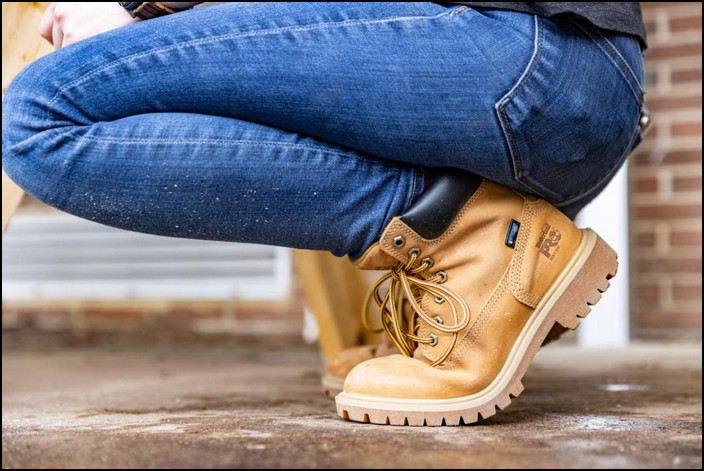
The insulation in the Premium boots provided extra warmth compared to the Heritage boots. It was perfect for icy conditions or activities where I would stand or walk outdoors for extended periods.
Despite the added insulation, my feet didn’t feel sweaty or overheated, thanks to the breathable design of the boots.
Like the Heritage boots, the padded collar and anti-fatigue footbed in the Premium Timbs added to the luxury feel.
Overall, the Heritage and Timberland Premium boots offered exceptional comfort.
But the winner for me would be the Timberland Premium boots. They are the perfect companion for any outdoor adventure, providing stability and warmth to tackle any terrain easily.
5. Style & Aesthetics
Embrace the rugged charm of a timeless classic with Timberland Heritage.
These boots embody the no-nonsense workwear aesthetic with the rich premium Timberland® leather and traditional silhouette. The thin layer that appears on the leather over time gives the shoe a unique look.
Expect a wide range of colors with the Heritage Timbs, including The iconic Olive Nubuck and Black Nubuck.
This Timberland collection is perfect for those who appreciate authenticity and heritage style.
These boots seamlessly blend into casual outfits, adding a ruggedness to jeans and tees or complementing a flannel shirt and chinos for a relaxed, casual vibe.
Elevate your look with a modern twist on the classic with the Timberland Premium.
The Premium line offers a sleeker, more refined design with smooth, full-grain leather and a simplified silhouette.
The color palette leans towards versatile neutrals like black, dark brown, and yellow, making them easily adaptable to various styles.
The overall aesthetic exudes a sophisticated look.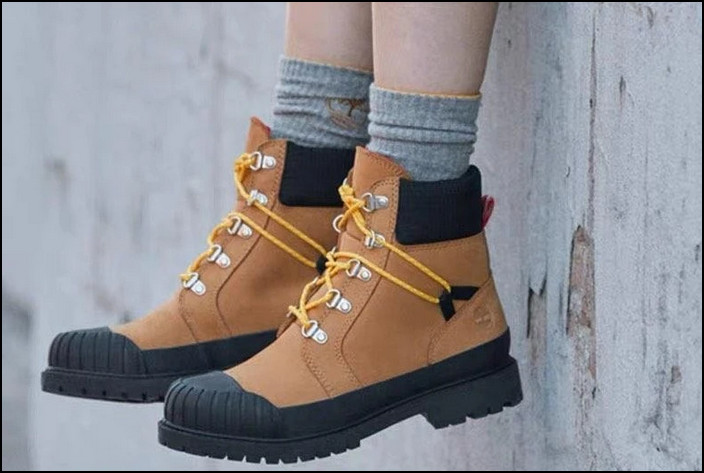
The Timberland Premium line seamlessly transitions from casual weekend wear to bright casual outfits. Pair them with dark wash jeans and a leather jacket for a stylish yet practical ensemble, or elevate your office attire with chinos and a button-down shirt.
The clean lines and neutral tones complement various styles without overpowering your outfit.
Ultimately, the Heritage line excels in casual and outdoor settings, while the Premium boots offer versatility for both simple and smart casual occasions.
6. Price & Value
Timberland Heritage and Premium boots offer quality construction and durable materials but differ in price and perceived value.
The Heritage line typically demands a higher price range, ranging from $198 to $220, while the Premium boots are priced slightly lower, ranging from $170 to $200.
Despite the price discrepancy, both lines maintain a reputation for durability and style, making them popular choices among consumers.
With their higher price point, the Heritage boots offer greater value due to their premium materials and craftsmanship. They feature additional detailing and design elements contributing to their higher price tag.
On the other hand, the Premium boots offer a more affordable option without compromising on quality. It makes these boots a practical choice for budget-conscious buyers.
Pros and Cons between Timberland Heritage and Premium Boots
By evaluating the positives and negatives of each Timberland series, you can select the one that aligns with your style, performance objectives, and comfort requirements. It ensures that the shoes you ultimately choose are a perfect match for your needs.
Let’s delve into the strengths and weaknesses of both Heritage and Premium Timberland boots.
Timberland Heritage
- »Soft and lightweight insulation.
- »Sustainable ReBOTL™ Material (50% recycled PET).
- »Waterproof Seam-Sealed Technology.
- »Premium Timberland® Leather.
- »Classic aesthetics.
- »More durable.
- »Lighter boots.
- »Suitable for casual wear in outdoor environments.
- »Lower insulation capacity.
- »More expensive.
- »Less comfortable.
Timberland Premium
- »Eco-friendly insulation (50% recycled PET).
- »Certified Tannery leather sourcing.
- »Faux shearling lining for warmth.
- »Anti-fatigue technology with geometric cone support.
- »Sleek design with full-grain leather.
- »Versatile neutral color palette.
- »Lower price range.
- »More comfortable.
- »Suitable for simple and smart casual occasions.
- »Perfect for cold weather.
- »Slightly heavier.
- »Less durable.
Timberland Premium Vs. Heritage: Which Boot Should You Get?
The debate between Heritage vs. Premium Timberland concerns prioritizing tradition or comfort.
For the purists, Heritage boots offer the classic Timberland look and feel, retaining the original design and materials. They’re durable but lack the comfort features of the Premium line.
For comfort seekers, Premium boots boast upgraded features like padded collars, thicker soles, and potentially better traction. They provide a more cushioned experience but are slightly less durable.
Ultimately, your best Timberlands depend on your needs and preferences. Consider your budget, desired level of comfort, and how you plan to use the boots.
Both Heritage and Premium options offer the original Timberland look and long-lasting quality, so you can’t go wrong with either!
FAQs
What is the difference between Original and Premium Timberlands?
Premium Timberlands are like comfy upgrades to the classic Originals! They have a thicker, multi-material sole for better support and cushion, plus a padded leather collar for a snugger fit. Both stay dry with waterproof nubuck leather, but Premiums might feel slightly taller and heavier due to the extra cushion.
How do Timberland premium boots fit?
Timberland Premium boots tend to run slightly big. For the classic 6-inch boots, go down half a size from your usual shoe size. Other styles, like hiking boots, might fit true to size. The leather will stretch slightly, so a snug initial fit is best.
Where are premium Timberlands made?
Timberland Premium boots are typically crafted in factories across Asia and Central America, including Vietnam, China, the Dominican Republic, and Bangladesh. While specific locations can vary, Timberland usually labels its products ‘Imported’ instead of listing the exact origin.
Are Timberland boots waterproof?
Most Timberland boots are waterproof. So, you can wear them in the rain. However, double-check your specific pair and look for terms like watertight or seam-sealed in the description.
Timberland Basic vs. Premium: Which Boot Should You Get?
Choosing between Timberland Basic and Premium boils down to comfort and budget. Both offer classic style and waterproof nubuck leather, but Premium boasts a thicker, comfier sole with added support and a padded ankle collar. Basic goes light on these features, keeping it more affordable but sacrificing some long-term comfort.
Do Timberland boots last long?
Yes, Timberland boots can last 4-5 years with proper care. They’re known for their tough leather, waterproof construction, and durable soles. Regular cleaning, conditioning, and sole replacements can extend their lifespan.

